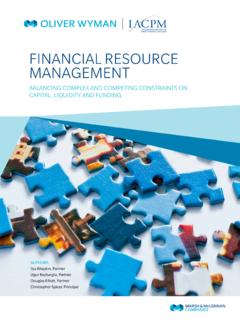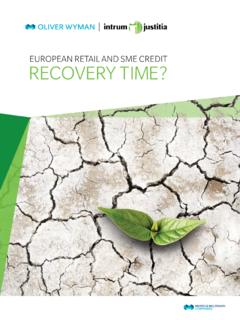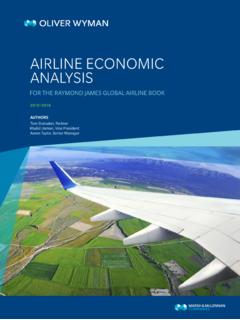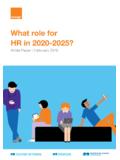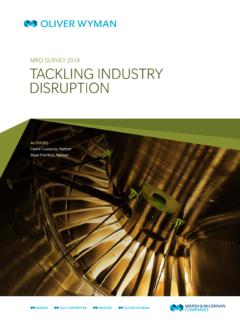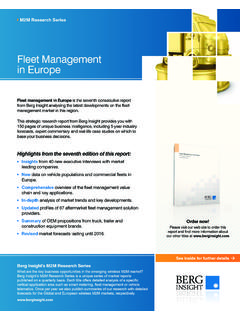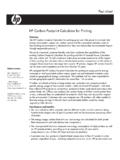Transcription of GLOBAL FLEET & MRO MARKET FORECAST COMMENTARY
1 GLOBAL FLEET & MRO MARKET . FORECAST COMMENTARY . 2018 2028. AUTHORS. Tom Cooper, Vice President John Smiley, Senior Manager Chad Porter, Technical Specialist Chris Precourt, Technical Analyst FOREWORD. Oliver Wyman's GLOBAL FLEET & MRO MARKET FORECAST COMMENTARY 2018 2028 marks our firm's 18th assessment of the 10-year outlook for the commercial airline transport FLEET and the associated maintenance, repair, and overhaul (MRO) MARKET . We're proud to say that the annually produced research, along with our Airline Economic Analysis (AEA), has become a staple resource of aviation executives whether in companies that build aircraft, fly them, or work in the aftermarket, as well as for those with financial interests in the sector through private equity firms and investment banks.
2 This research focuses on airline FLEET growth and related trends affecting aftermarket demand, maintenance costs, technology, and labor supply. The outlook reveals significant changes that are important to understand when making business decisions and developing long-term plans. As you will see from the report, the next decade holds great opportunities and challenges for the industry as both technological innovation and the move away from traditional energy sources redefine business as usual across industries and the globe.
3 This will be an era of disruptive growth, driving companies to ask tough, fundamental questions about what it will take to stay relevant and expand. In conjunction with the FLEET and MRO FORECAST , we conduct an annual survey on hot topics, critical issues, and new opportunities across the maintenance, repair, and overhaul space. To participate in this year's edition, please contact the research team at Oliver Wyman's Aviation Competitive & MARKET Intelligence team, partners, and vice presidents are available to assist with any questions about this FORECAST , as well as the AEA.
4 We hope you find the data and insights valuable as you refine your business models and develop strategies for moving forward. Best regards and wishes for a wonderful 2018, Tom Cooper Vice President and Study Leader January 18, 2018. Copyright Oliver Wyman CONTENTS. EXECUTIVE SUMMARY 1. STATE OF THE INDUSTRY 7. FLEET FORECAST 20. MRO MARKET FORECAST 34. ECONOMIC SENSITIVITY ANALYSIS 42. Copyright Oliver Wyman 1. EXECUTIVE. SUMMARY. Executive Summary EXECUTIVE SUMMARY. These are heydays for the commercial aviation industry as well as businesses supporting it from the maintenance, repair, and overhaul (MRO) sector.
5 For the first time in airline history, carriers recorded three consecutive years of record or near record profits, thanks to constrained fuel prices and operational efficiencies. Rising demand for air travel is keeping production lines at aircraft, engine, and component manufacturers busy and setting records. Lower oil prices, along with the willingness of airlines to spend on upkeep, are resulting in delayed retirements of older jets, which in turn provide more business for the MRO industry because of their additional servicing needs.
6 And despite recent political instability and rising GLOBAL tensions, aviation seems headed for more of the same at least over the short term. Across economies both developed and developing increases in gross domestic product (GDP). and disposable income, as well as expanding middle classes, are producing an unprecedented GLOBAL demand for passenger air travel and cargo transport. In China, where the size of the middle class now equals the population of the United States, demand for air travel is expected to grow percent annually between 2018 and 2028, despite a slight slowing in economic growth over the same 10 years.
7 While for decades air travel rose in tandem with GDP, increased demand this year and in the next several will help it outpace economic growth in most regions, particularly in emerging markets like Asia and Latin America. In Asia, for instance, air travel is expected to expand percent in 2018, while real GDP that is, adjusted for inflation will rise percent. Even in more mature economies, this trend is evident: In 2017, air passenger miles rose four percent in North America versus a percent increase in GDP and eight percent in Europe versus GDP growth of percent.
8 In Eastern Europe, where little growth was expected, the industry is seeing airlines such as Budapest-based Wizz Air place large aircraft orders. Wizz expects delivery of nearly 300 Airbus A320 family aircraft between now and 2027. Myriad reasons have led to this intensified demand for air travel. They include rising disposable income in emerging markets, expanding numbers globally of well-off retirees with a propensity to travel, an increase in digital connectivity worldwide through the use of digital boarding passes, greater Wi-Fi accessibility, and on-board tablet usage that makes flying easier.
9 Additionally, a spike in the number and size of low-cost carriers and ultra-low-cost carriers has created downward pressure on airfares and other travel costs. Responding to the demand, US airlines increased available seat miles (ASM) percent during 2017. across both domestic and international operations. The year-over-year growth was the largest since the 2007 2009 worldwide economic recession, according to the 2018 Oliver Wyman Airline Economic Analysis (AEA). The swelling demand continues to drive expansion of the GLOBAL FLEET .
10 Where in our 2017 2027. FORECAST we projected annual growth averaging percent, our current outlook ratchets up that yearly increase to percent. Copyright Oliver Wyman 2. Executive Summary Inevitably, all this spells more business for the major aircraft manufacturers, pushing production rates to levels never seen before for commercial aircraft. The two biggest Boeing and Airbus have reported they expect their production of Boeing 737s and A320s to reach an unprecedented 60. aircraft per month each sometime in 2019. This compares with 42 per month as recently as 2015 a jump of 43 percent in just four years.

